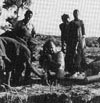This link established to a quote from Marc Augé’s latest book on Oblivion brought me to follow some associative traces of the memory path simultaneously connecting between remembrance and forgetting. As a still remarkable example to see the impact and power of these technics I point to Jean Rouche’s film ‘Les Maitres Fous’. Here the ritual of recalling constituted by an almost literal possession not only opens the path of trespassing and rebeginning for the directly involved but also marks a strong and disturbing memory trace of colonial impact on subpressed cultures. Accentuating the lingering effect of memory traces and their intertwined relation with oblivion as indentation not only crucial to individual routes but also fundamental in the shaping of cultural narratives.
… However, even as oblivion is the “life force†of memory (p. 21), it is also a perpetually elusive and insubstantial force. He [Augé] draws on the psychoanalytic concept of memory trace to elucidate this mystery and thus establishes a dynamic that rests at the heart of the essay. The memory trace parades as true memory – a snapshot of the past – when in fact it is a mere representation. It can never capture the absent moment toward which it merely points. The absence signified by the memory trace is the product of oblivion, always present and active in the production of memory, always an object of desire, yet forever out of reach – a foundation without substantial form. ….
… connecting points of this review of Marc Augé’s book ….
… Augé, then, identifies three figures of oblivion: return, suspension, and rebeginning. In the form of social rites these figures of oblivion join the individual to the group. Through these rites, oblivion also structures the relationship between past, present, and future, undoing their established narrative inter-relations and making possible an escape from the weight of any single time or memory. The first figure of oblivion is return, and it is exemplified through rites of possession. In possession, the individual is inhabited by a presence that takes over the self and speaks through him or her as an ancestor, establishing a continuity with the past – as if time had never gone on. The oblivion of return requires a total forgetfulness of self so that old habits and forms of life can be re-lived. The second figure of oblivion is suspense and it is exemplified through role inversions, when, for example, on the day of carnival, a man becomes a woman, or a slave becomes a master. The weight of the past and the future are forgotten so that one can live in a disconnected and inconsequential present. The third figure of oblivion is rebeginning, which forms its relation to time once the past and the present are forgotten, and the future is not yet determined. It is a “radical inauguration†(p. 57) realized in social rituals of initiation, embodying the hope of starting over again. …
.. to ‘Les Maitres Fous‘ one of the most famous films of Jean Rouch
(former post on Rouch):
| … Yet, as Rouch reminds us in an interview in Cineaste, possession for the Hauka cultists was not theater but reality. The significance of this reality is left ambiguous in the film, although Rouch’s commentary suggests that the ritual provides a psychological release which enables the Hauka to be good workers and to endure a degrading situation with dignity. The unexplored relation of the Hauka movement to their colonial experience is perhaps the most intriguing issue raised by this ceremony in which the oppressed become, for a day, the possessed and the powerful…. |


images via www.haussite.net and www.der.org |
.. an other review on the art of recalling and forgetting which points also out the spatial implications of memory traces acn be found at Culture Machine.


